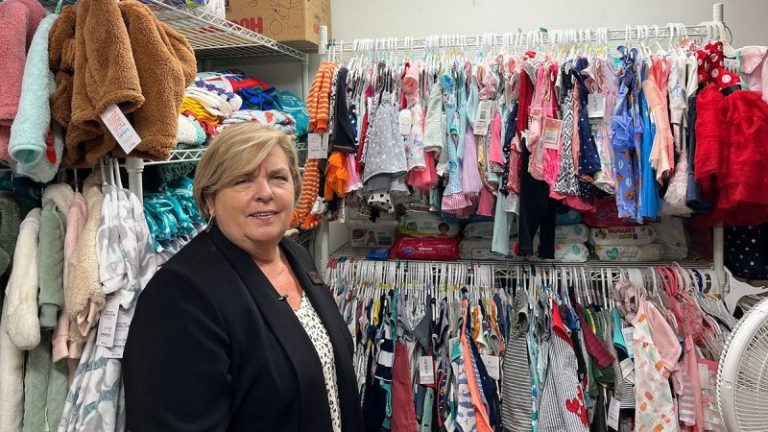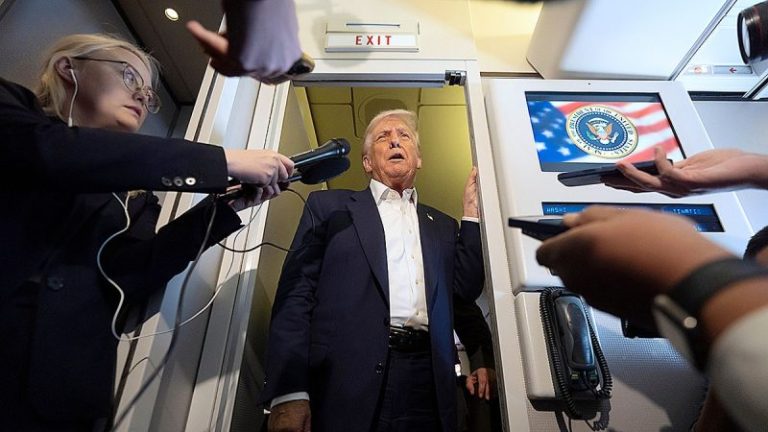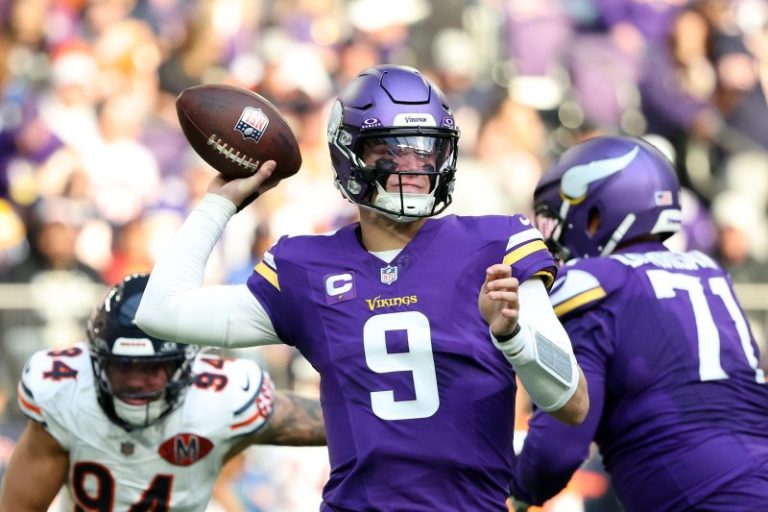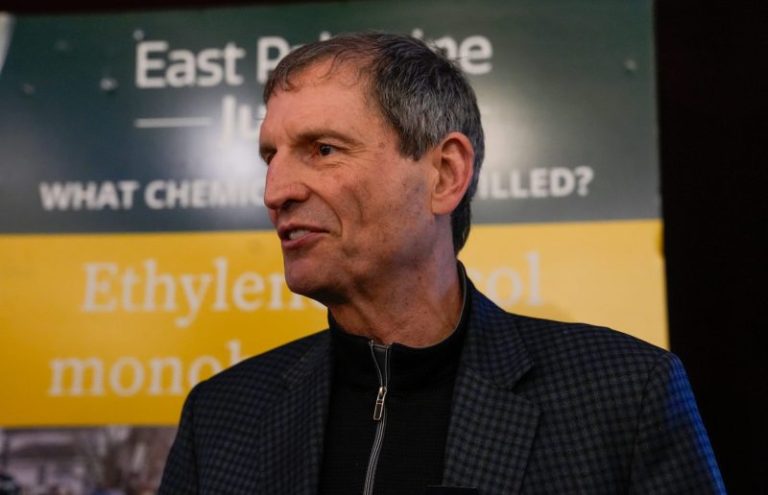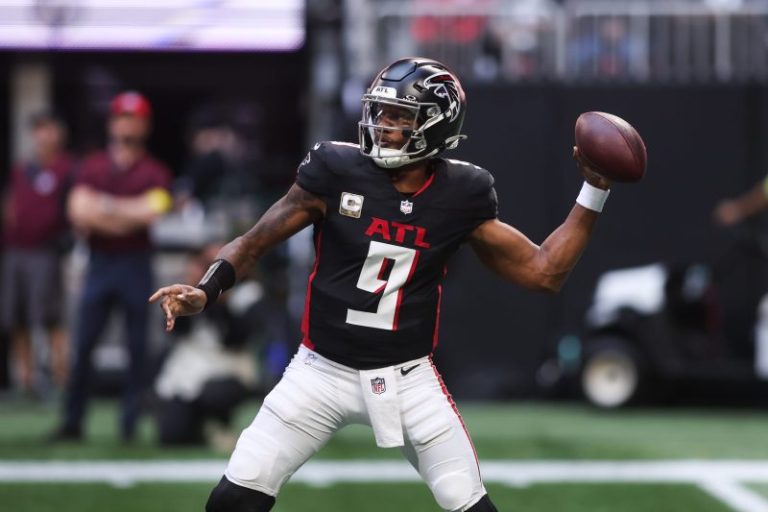The Denver Broncos defeated the Kansas City Chiefs, taking a significant lead in the AFC West standings.
Carolina Panthers quarterback Bryce Young threw for a career-high 448 yards in an overtime win against the Atlanta Falcons.
The Kansas City Chiefs fell to 0-5 in one-score games this season after their loss to the Broncos.
You could forgive any observers for thinking that Week 11 in the NFL felt like a preamble to the playoffs.
The regular season, of course, is not even two-thirds complete, with a shifting postseason picture sure to undergo more upheaval in the coming weeks. But Sunday’s schedule was dotted with matchups that pitted top teams against one another, creating a distinct sense of heightened stakes even as franchises still have time to sort themselves out down the stretch. And after some notable setbacks, a few aspiring contenders will need to do exactly that.
Here are the biggest winners and losers from Week 11 in the NFL:
NFL Week 11 winners
Josh Allen
When the NFL’s reigning MVP threw an absolutely confounding interception on the second play of the game, it certainly seemed as though Allen was pressing things. And who could blame him? With the Buffalo Bills’ passing offense decidedly out of sorts this season, it only made sense that the Buffalo Bills quarterback would try to spark a little magic all by himself against the Tampa Bay Buccaneers, even if it led to some of the regrettable decisions that dotted the first two years of his NFL career. From there, however, he gave the Bills a much more desirable variety of vintage Allen performance.
In a game that featured nine lead changes, Allen conveyed the ultimate edge by notching six touchdowns: three passing, three rushing. That feat has only been achieved by a quarterback one other time in the Super Bowl era … by Allen himself last year against the Los Angeles Rams. He wasn’t always on-point on Sunday, but strikes like his 43-yard touchdown to former undrafted free agent Tyrell Shavers – who led the team with 90 receiving yards on the day – underscored that Allen remains an almost singular force behind center.
Buffalo has gone to great lengths to ensure that Allen doesn’t have to go into world-beater mode with regularity. Days like this, though, reinforce that it’s nice to be able to turn to that capability when needed.
Sean Payton
For most coaches, getting flagged when an official crashes into you would be the harbinger of a difficult day. Payton wasn’t any worse for the wear after his collision, though, and his Denver Broncos might have secured a true AFC West changing of the guard with their 22-19 win over the Kansas City Chiefs on Sunday.
The Broncos’ bona fides had been under serious scrutiny amid a seven-game win streak, with many doubting whether Bo Nix’s habit of flipping the switch in the fourth quarter after enduring slow starts would eventually be the team’s undoing. Against Kansas City, Nix was steady but still tapped into some late heroics to set up Wil Lutz’s winning field goal and a three-and-a-half-game advantage over the Chiefs in the standings. Denver also managed to do what few teams have been able to accomplish in dictating terms to Patrick Mahomes, who was kept out of rhythm and seemed to be proactively accounting for a pass rush that extended its league-best sack tally to 49. This is almost an unfathomable outcome for an organization that 20 months ago was staring down an imposing reset after releasing Russell Wilson, but Payton deserves a world of credit for elevating the Broncos to this level after the post-Super Bowl 50 doldrums.
Bryce Young
While Rico Dowdle and the ground game have taken off in 2025, the Carolina Panthers couldn’t find any semblance of a downfield passing attack, with Young being held under 200 yards in his last seven games. But with the team’s rushing operation held in check Sunday against the Atlanta Falcons, Young responded by slinging for a career-high and franchise-record 448 yards and three touchdowns to power a 30-27 overtime victory.
On a day when Young suffered an ankle injury in the first quarter, the former No. 1 overall pick could have reverted to a more conservative mode to protect himself. Instead, he fired impressive shots downfield, with 11 of his 31 completions coming at least 10 yards beyond the line of scrimmage. Young managed all that despite being pressured 19 times and taking five sacks, with Carolina’s front doing him few favors in the form of consistent protection or establishing a push for Dowdle.
It’s worth noting, however, that the Falcons were without cornerbacks Mike Hughes and Dee Alford, so this performance might not be indicative of any emerging trend. But given the upcoming two-game stretch against the San Francisco 49ers and Los Angeles Rams, the Panthers’ win was nothing short of vital for the team’s playoff hopes, and Carolina needed every bit of what Young could muster.
Jacksonville Jaguars offense
After last week’s fourth-quarter collapse in a loss to the Houston Texans, the Jaguars looked as though their season might come apart at the seams, with two-way rookie Travis Hunter Jr. being lost for the rest of the way due to a knee injury and top wideout Brian Thomas Jr. remaining out against the Los Angeles Chargers. But first-year coach Liam Coen put together arguably one of the most impressive outings of the week in a 35-6 romp that kept his team in the thick of the AFC playoff hunt.
The run game that Coen has single-handedly revitalized led the way, with Travis Etienne Jr. and rookie Bhayshul Tuten each doing major damage as Jacksonville posted 192 yards and four touchdowns on the ground. That eased the demand on Trevor Lawrence, who threw for just 153 yards on 14-of-22 passing with his top weapons out of commission. The five-touchdown day and season-high scoring output marked a major breakthrough, especially given that the Chargers’ typically stout defense surrendered just 40 points in the previous three games combined. More encouraging signs came from a defense that also controlled the line of scrimmage, allowing just 42 yards on 16 carries while doling out more punishment with its pass rush.
With two matchups against the division-leading Indianapolis Colts looming and an otherwise manageable schedule ahead, Jacksonville still has a decent shot at mounting a push for the AFC South crown.
Sean Tucker
The former Syracuse standout went undrafted in 2023 when a congenital heart condition flagged at the combine clouded his stock. Since then, he’s hovered in the background as a promising but underused backfield option, averaging 6.2 yards per carry last year as a backup with the Buccaneers. But with Bucky Irving still out, Tucker capitalized with a head-turning showing against the Bills.
Tucker finished with 140 yards from scrimmage and three total touchdowns on 21 touches. He churned through would-be tackles by generating 52 yards after contact, but the third-year ball carrier also proved to be patient yet explosive, including on a 43-yard scoring scamper to the outside. Tucker will be a free agent this offseason, and he’s demonstrated enough to take on a role elsewhere as part of a potential time share in the backfield.
San Francisco 49ers stars
Welcome back, Brock Purdy. The quarterback returned to the lineup after a six-game absence due to a toe injury, and he had little trouble rediscovering his comfort zone while passing for 200 yards and three touchdowns in a 41-22 win over the Arizona Cardinals. Purdy’s presence was a welcome sight for George Kittle, who hauled in all six of his targets for 67 yards and two touchdowns. Christian McCaffrey also took advantage of the Cardinals’ shaky defense, piling up 121 yards from scrimmage and three total touchdowns. Wide receiver Ricky Pearsall had just one catch after missing the previous five tilts with a knee injury, but with upcoming games against the Panthers, Browns and Titans, there’s time for him to round back into form.
Chicago Bears
After their 19-17 escape against the Minnesota Vikings and the Detroit Lions’ loss to the Philadelphia Eagles on ‘Sunday Night Football,’ the Bears are in sole possession of first place in the NFC North at 7-3. Even the rosiest of projections couldn’t have foreseen that outcome through the first 11 weeks of Ben Johnson’s tenure. There’s plenty to like here, from an explosive offense that has managed to get its ground game going to the defense’s remarkable penchant for generating takeaways, with their 22 representing the most for any team through 10 games since 2022. There’s certainly a sustainability question for a group that’s well ahead of schedule and has two dates remaining with the rival Green Bay Packers, but Chicago should remain at the forefront of the NFC playoff push even if it doesn’t complete a worst-to-first transformation.
NFL Week 11 losers
Chiefs’ late-game magic
Prevailing in these close contests last year seemed like a sure thing for Kansas City, which pushed out to a record 17-game win streak in one-score affairs. Regression was rightfully expected, but it’s hit harder than anyone could have thought as the Chiefs now fell to 0-5 in such contests in 2025.
As always, the truth of this team’s true nature rests somewhere in the middle of the two extremes. It was clear that last year’s 15-2 group wasn’t as outright dominant as its record suggested. And this year’s edition is hardly your run-of-the-mill 5-5 operation. But that’s the Chiefs’ reality, and things only stand to get more difficult for a team that next has to face the Colts as it tries to scrape back into position merely for a wild-card spot. This much is clear, though: Winning on the margins is no longer a foregone conclusion for Kansas City.
Sam Darnold
It’s not fair to saddle the Seattle Seahawks quarterback with the same tropes that seemed to define his play in the early years of his career, when he looked destined to go down as a draft bust. Teammates and coaches, too, came to his defense despite his four-interception unraveling in a 21-19 loss to the Los Angeles Rams, with linebacker Ernest Jones IV offering up a particularly noteworthy and explicit backing. But Darnold’s turnover tendencies are not an aberration – he entered the week with 10 giveaways – and they now figure to loom over the remainder of the season amid what’s been a spectacular offensive reinvention for Seattle.
Darnold’s knack for pushing the ball vertically has fueled an offense that entered Sunday as the league’s third-highest scoring offense despite the lack of a reliable ground game that coach Mike Macdonald was counting on. But as the calamitous end to his resurgent season with the Vikings last year established, his problems escaping pressure and his lapses in decision-making have a way of feeding into one another. Against the Rams – who also hammered him in a wild-card win over Minnesota last year – that vicious cycle repeated once again, with Darnold’s fourth pick coming on a cringeworthy fourth-quarter jump pass that went directly to cornerback Darious Williams. No need to sound an alarm yet, but if Darnold and the Seahawks can’t find a way to settle down against top competition like the Rams, it will be difficult to trust their NFC contender credentials.
J.J. McCarthy
Engineering an 85-yard go-ahead drive – capped by a 15-yard touchdown pass to Jordan Addison – late in the fourth quarter prevented his day from going down as a downright disaster. But that late flourish still wasn’t enough to give the Vikings any sort of lasting confidence about their quarterback, who was otherwise once again inaccurate and unsettled.
McCarthy tossed two interceptions and connected on just 16 of 32 passes despite seldom facing pressure from the Bears defense. Until the last drive, he had not completed a pass in the second half. To be fair, the passing attack’s problems don’t fall entirely on him, as Addison had a pair of costly drops. But catering to the young quarterback’s inexperience has come at a clear cost. McCarthy remains a presence to be managed rather than unleashed, and it’s not clear when – or if – he’ll get to the point where he can consistently attack the middle of the field and put the proper touch on his throws. Kevin O’Connell has taken a delicate approach with the passer, but Justin Jefferson slamming his helmet after yet another errant throw was telling about the toll this arrangement is taking. Giving up on a first-round quarterback with five starts to his name would be premature, but Minnesota is under mounting pressure to figure out whether McCarthy can be trusted to hold down his spot next year without some form of insurance. All the while, 2025 threatens to slip away for the Vikings.
Los Angeles Chargers
The Bolts have been trying to chase off the ghosts of their AFC wild-card loss to the Jaguars ever since the historic collapse in January 2023. Brandon Staley couldn’t manage to do so, and it cost him his job. Jim Harbaugh, however, helped the franchise chart a new course with last year’s 11-6 turnaround. But while Sunday’s rematch between Los Angeles and Jacksonville wasn’t as debilitating for the former as that postseason stunner was, it does seem like it could end up encapsulating the limitations facing this year’s roster.
The problems up front for a line that has lost Rashawn Slater and Joe Alt have been evident for some time, with Justin Herbert being subjected to an astronomical number of hits on a weekly basis. In this state, the Chargers simply can’t play the brand of football that Harbaugh covets, as the team can’t hold up in the trenches on either side of the ball. At 7-4, the Bolts have exhibited some creativity in circumventing those shortcomings, and that could help carry them to the playoffs. But the ceiling has been lowered considerably, with this outing leaving the distinct feeling that the team wouldn’t be able to put up much of a fight in the postseason.
Jalin Hyatt
The 2023 third-round pick has had a highly disappointing run with the Giants, as he’s essentially been a non-factor for the last two seasons on a passing attack that surely could use big-play ability. Yet Hyatt might have reached the nadir of his run with Big Blue on Sunday, when he seemed to stop in the end zone on a corner route, allowing Packers safety Evan Williams to secure an interception that extinguished any hopes of a comeback.
Asked about the play afterward, Hyatt took accountability but offered little insight, saying only, ‘(I) just got to make a play, simple as that.’ Now, however, he might not have many more opportunities to do so for New York.
This post appeared first on USA TODAY

